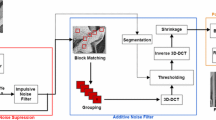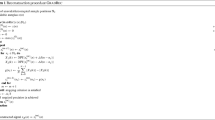Abstract
The paper presents a method for denoising and reconstruction of sparse images based on a gradient-descent algorithm. It is assumed that the original (non-noisy) image is sparse in the two-dimensional Discrete Cosine Transform (2D-DCT) domain. It is also assumed that a number of image pixels is corrupted by a salt and pepper noise. In addition, we assume that there are pixels corrupted by a noise of any value. In this paper we introduce a method to find the positions of the corrupted pixels when the noise is not of the salt and pepper form. The proposed algorithm for noisy pixels detection and reconstruction works blindly. It does not require the knowledge about the positions of corrupted pixels. The only assumption is that the image is sparse and that the noise degrades this property. The advantage of this reconstruction algorithm is that we do not change the uncorrupted pixels in the process of the reconstruction, unlike common reconstruction methods. Corrupted pixels are detected and removed iteratively using the gradient of sparsity measure as a criterion for detection. After the corrupted pixels are detected and removed, the gradient algorithm is employed to reconstruct the image. The algorithm is tested on both grayscale and color images. Additionally, the case when both salt and pepper noise and a random noise, within the pixel values range, are combined is considered. The proposed method can be used without explicitly imposing the image sparsity in a strict sense. Quality of the reconstructed image is measured for different sparsity and noise levels using the structural similarity index, the mean absolute error, mean-square error and peak signal-to-noise ratio and compared to the traditional median filter and recent algorithms, one based on the total-variations reconstruction and a two-stage adaptive algorithm.






Similar content being viewed by others
References
Baraniuk RG (2007) Compressive sensing. IEEE Signal Process Mag 24(4):118–121
Candes EJ (2008) The restricted isometry property and its implications for compressive sensing. Comptes Rendus Mathematique 346(9-10):589–592
Candes EJ, Wakin M (2008) An introduction to compressive sampling. IEEE Signal Process Mag 25(2):21–30
Candes EJ, Romberg J, Tao T (2006) Robust uncertainty principles: Exact signal reconstruction from highly incomplete frequency information. IEEE Trans Inf Theory 52(2):489–509
Caselles V, Chambolle A, Novaga M (2011) Total variation in imaging. Handbook of Mathematical Methods in Imaging, Springer, New York, pp 1016–1057
Djurovic I (2016) BM3D filter in salt-and-pepper noise removal. EURASIP J Image Video Process 2016(13): . doi:10.1186/s13640-016-0113-x
Donoho DL (2006) Compressive sensing. IEEE Trans Inf Theory 52(4):1289–1306
Donoho D, Elad M, Temlyakov V (2006) Stable recovery of sparse overcomplete representations in the presence of noise. IEEE Trans Inf Theory 52:6–18
Elad M (2010) Sparse and redundant representations: From theory to applications in signal and image processing. Springer, New York
Figueiredo MAT, Nowak RD, Wright SJ (2007) Gradient projection for sparse reconstruction: Application to compressed sensing and other inverse problems. IEEE J Sel Top Signal Process 1(4):586–597
Fornasier M, Rauhut H (2008) Iterative thresholding algorithms. Appl Comput Harmon Anal 25(2):187–208
Guo D, Qu X, Du X, Wu K, Chen X (2014) Salt and pepper noise removal with noise detection and a patch-based sparse representation. Advances in Multimedia 2014, article ID 682747
Huang S, Zhu J (2010) Removal of salt-and-pepper noise based on compressed sensing. Electron Lett 46(17):1198–1199
Koivisto P, Astola J, Lukin V, Melnik V, Tsymbal O (2003) Removing impulse bursts from images by training-based filtering. EURASIP Journal in Advances in Signal Processing
Lukin VV, Oktem R, Ponomarenko N, Egiazarian K (2007) Image filtering based on discrete cosine transform. Telecommun Radio Eng 66(18):1685–1701
Lukin VV, Ponomarenko N, Egiazarian K, Astola J (2008) Adaptive DCT-based filtering of images corrupted by spatially correlated noise. Proceedings SPIE Conference Image Processing: Algorithms and Systems VI 6812
Luo W (2006) An efficient detail-preserving approach for removing impulse noise in images. IEEE Signal Processing Letters, 10.1109/LSP.2006.873144
Lourakis M (2016) TV-L1 Image Denoising Algorithm. https://www.mathworks.com/matlabcentral/fileexchange/57604-tv-l1-image-denoising-algorithm
Ramadan Z (2012) Efficient restoration method for images corrupted with impulse noise. Circ, Syst, Signal Process 31(4):1397–1406
Rauhut H, Schnass K, Vandergheynst P (2008) Compressed sensing and redundant dictionaries. IEEE Trans Inf Theory 54(5):2210–2219
Stanković S, Orović I, Stanković L (2014) An automated signal reconstruction method based on analysis of compressive sensed signals in noisy environment. Signal Process 104:43–50
Stanković L (2015) Digital signal processing with selected topics. CreateSpace Independent Publishing Platform, An Amazon.com Company
Stanković S, Orović I, Sejdić E (2012) Multimedia signals and systems. Springer-Verlag, New York
Stanković L, Daković M, Vujović S (2014) Adaptive variable step algorithm for missing samples recovery in sparse signals. IET Signal Process 8(3):246–256
Stanković I, Orović I, Stanković S (2014) Image reconstruction from a reduced set of pixels using a simplified gradient algorithm 22nd Telecommunications Forum TELFor. Belgrade, Serbia
Stanković L, Stanković S, Amin M (2014) Missing samples analysis in signals for applications to L-estimation and compressive sensing. IEEE Signal Process Lett 94:401–408
Stanković L, Daković M, Vujović S (2016) Reconstruction of sparse signals in impulsive disturbance environment. Circuits, Systems and Signal Processing 35, in print
Stanković I, Orović I, Stanković S, Daković M (2016) Iterative denoising of sparse images. 39th International Convention on Information and Communication Technology Electronics and Microelectronics MIPRO, Opatija, Croatia
Srinivasan KS, Ebenezer D (2007) A new fast and efficient decision based algorithm for removal of high- density impulse noises. IEEE Signal Processing Letters doi:10.1109/LSP.2006.884018
Studer C, Kuppinger P, Pope G, Bolcskei H (2012) Recovery of sparsely corrupted signals. IEEE Trans Inf Theoory 58(5):3115–3130
Wang X-L, Wang C-L, Zhu J-B, Liang D-N (2011) Salt-and-pepper noise removal based on image sparse representation. Opt Eng 50(9):article ID 097007
Wang Z, Bovik AC, Sheikh HR, Simoncelli EP (2004) Image quality assessment: From error visibility to structural similarity. IEEE Trans Image Process 13 (4):600–612
Zhang B, Zhu Z, Wang S (2016) A simple primal-dual method for total variation image restoration. J Vis Commun Image Represent 38(C):814–823
Acknowledgments
This work is supported by the Montenegrin Ministry of Science, project grant funded by the World Bank loan: CS-ICT “New ICT Compressive sensing based trends applied to: multimedia, biomedicine and communications”.
Author information
Authors and Affiliations
Corresponding author
Rights and permissions
About this article
Cite this article
Stanković, I., Orović, I., Daković, M. et al. Denoising of sparse images in impulsive disturbance environment. Multimed Tools Appl 77, 5885–5905 (2018). https://doi.org/10.1007/s11042-017-4502-7
Received:
Revised:
Accepted:
Published:
Issue Date:
DOI: https://doi.org/10.1007/s11042-017-4502-7




